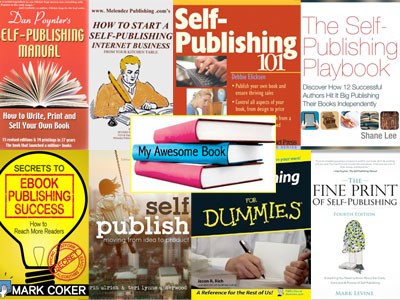Several of the best new books I’ve read lately have had one thing in common: They’ve lacked any sort of publisher’s imprint on the inside cover or title pages.
Self-publishing, in either hardcopy or e-book format, is a fast-growing sector, driven by authors too impatient to wait for a traditional publisher’s verdict on their work, or optimistic they can market their tome and drive sales without standard publishing infrastructure.
A survey from late 2013 by the industry analyst Bowker found that self-published titles in 2012 jumped 60 percent over 2011, and that e-books accounted for 40 percent of self-published works in the same year. This Huffington Post blogger predicts that self-published titles will comprise at least 50 percent of e-books by 2020, and echoing analysis I’ve seen elsewhere, notes that readers aren’t looking to publishers’ imprints as a sign of quality, like they used to.
One thing you need to do for audiences right off the bat is distinguish between self-publishing and vanity publishing; the latter usually involves the writer making a cash payment to a “publisher” who promises to print the book. Traditionally this has been seen as something of a scam, taking advantage of hopeful amateur writers. In self-publishing, the author purchases services on an as-needed basis and the transactions are transparent; this blog post from About.com does a good job of explaining the difference between old-style vanity press publishing and today’s indie or self publishing realm; you should probably generate a fact box with such information if you’re writing a how-to or personal finance piece. Here are some caveats from the Science Fiction and Fantasy Writers of America, too.
Industry bible Publisher’s Weekly forecast in January that “author service companies” that provide design, editing and other advice to DIY authors would be growing apace, as well. That’s another small business niche you might explore; are people making any kind of a living editing and designing others’ books and novels? This service provider directory from BookWorks, a professional group for authors and those related to the self-publishing trade, certainly is extensive; unfortunately the list isn’t sortable by state or ZIP code but I’d imagine a Craigslist search would turn up some editors, proofreaders and so on in your area. I couldn’t locate a reputable state-by-state directory but found local print-on-demand firms via a Google search.
You also could check with local chapters of the Mystery Writers of America and the Romance Writers of America to find authors and industry members (literary agents, for example, often belong — how’s their business faring as more authors cut out the middlemen in favor of targeting readers directly?) for their take on the pros and cons of DIY. Self-publishing of erotica is hot in more ways than one, especially following the success of “50 Shades of Grey.” Publisher’s Weekly says successful self-published writers of steamy tomes can rake in $100,000 a month purveying their stories online; can you locate any local indie authors willing to provide details on their business model and tips for would-be rivals?
Electronic or print editions
Hopeful independent authors need to decide whether to market electronic versions of their books (usually through Amazon) or print versions or both. Again, talk with local folks about the pros and cons — and there is plenty of online advice from sources like Writers and Editors or in articles like “A publisher’s perspective on profits: Ebooks vs. print.” If you’re looking for business-model information, don’t forget to talk to analysts of the traditional publishing arena.
And note that even Publisher’s Weekly has begun reviewing independently published books; here’s a link to its BookLife site that will give you more insight into the industry.
This blog post by mystery writer J.A. Konrath is five years old but will give you some background info to start with; he posts actual numbers for what he earned on e-books sold through his publisher vs. e-books he sold directly himself; the 2009 disparity between the two figures (he makes a lot more selling directly) is kind of amazing. I wonder though, as more and more e-books and authors are out there, is the potential income per author becoming very diluted?
How to market your books
Marketing techniques are another angle you can focus on; how are indie authors selling their wares? Websites, social media, speaking engagements, selling directly to libraries (which offer a lot of e-books these days) and getting space in bookstores are some tactics. What about special-interest rallies or trade shows; one of the books I recently read was by a woman who threw over her traditional life to become a full-time RVer. She’s thinking of asking campground sundries shops and other related venues to sell her memoirs.
How-to books, software that helps construct plots and other goods that purport to reveal the secrets of a successful writing career have been around since they were advertised on matchbook covers; today’s equivalent seems to be apps, like WriteChain, which prompts authors to meet word-count goals. If you’re doing a personal finance story about the writing life, be sure to include expenses for items like apps, professional memberships, research and other costs of doing business.
And here’s an AARP article about avoiding self-publishing scams.










